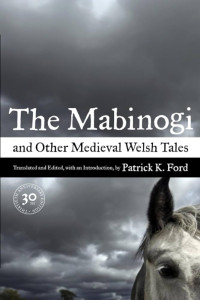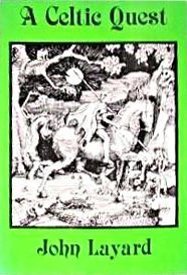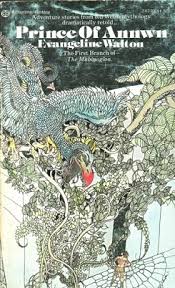Patrick Ford, translator and editor’s The Mabinogi and other Medieval Welsh Tales (University of California Press, 1977)
John Layard, editor’s A Celtic Quest: Sexuality and Soul in Individuation (revised by Anne S. Bosch) (Spring Publications, 1975)
Lloyd Alexander’s The Black Cauldron (Yearling, 1969, reissued 1999)
Lloyd Alexander’s The Book of Three (Yearling, 1969, reissued 1999)
Lloyd Alexander’s The Castle of Llyr (Yearling, 1969, reissued 1999)
Lloyd Alexander’s The Foundling and other Tales of Prydain (Yearling, 1996)
Lloyd Alexander’s The High King (Yearling, 1969, reissued 1999)
Lloyd Alexander’sTaran Wanderer (Yearling, 1969, reissued 1999)
Evangeline Walton’s Prince of Annwn (Ballantine, 1974; The Overlook Press, 2002)
Evangeline Walton’s The Children of Llyr (Ballantine, 1971; The Overlook Press, 2002)
Evangeline Walton’s The Island of the Mighty (Ballantine, 1936, 1974; The Overlook Press, 2002)
Evangeline Walton’s The Song of Rhiannon (Ballantine, 1972; The Overlook Press, 2002)
 The Mabinogion, as it is commonly known, was introduced to the English-speaking world by Lady Charlotte Guest in the nineteenth century, and has since provided the source material for many popular novels and several translations. Many readers are likely approaching the original stories because they loved the modern adaptations or want to reconcile the differences in plot and characterization between the modern works. Of course, the translators’ and editors’ comments reveal as much about their own world view as they do about the texts, and the focus often shifts away from the stories to the point the translators and editors are trying to make.
The Mabinogion, as it is commonly known, was introduced to the English-speaking world by Lady Charlotte Guest in the nineteenth century, and has since provided the source material for many popular novels and several translations. Many readers are likely approaching the original stories because they loved the modern adaptations or want to reconcile the differences in plot and characterization between the modern works. Of course, the translators’ and editors’ comments reveal as much about their own world view as they do about the texts, and the focus often shifts away from the stories to the point the translators and editors are trying to make.
Patrick Ford wanted to make the stories accessible to modern readers without the quaintness of the 19th-century translations, sacrificing some literal renditions of the Welsh to remain true to the spirit of the original stories. Medieval Welsh has more modes of addressing people than 20th century English, and trying to reflect this results in a “King James” version of the stories. A more literal translation can be found in the Jones & Jones edition first published in 1948. I find Ford’s translation does a great job of making the interactions between the characters seem natural and unforced, and that descriptions of characters are well done.
One great thing about Ford’s translations is the art of swearing — most speeches begin with an oath or two, usually “By God ….” If you’ve ever been treated to one of those “how good we are at cursing” treatises in an Irish North American bar, you’ll appreciate what I mean about this being an ancient and enduring trait of Celtic speech patterns.
Some descriptions of action sequences and standard phrases are a bit awkward, however. For example, in “Manawydan Son of Llyr,” the time between episodes is indeterminate, and Ford repeatedly uses the phrase “however long they” when it seems to me that the phrase “after awhile” would have been much less distracting. Each time one of these little gems comes up, attention is drawn away from the stories, reminding the reader that this is an old story and we do not quite get all of it.
Ford’s introduction to each of the stories helps put them into the context of Welsh oral tradition, and provides links to other Celtic traditions, particularly the Irish. He focuses on the perennial favorites: the role of pre-Romance King Arthur, the antiquity of the stories in oral tradition, what the stories reveal about gender roles, and the changes that Christian monks added when committing them to writing. It is pretty clear that a lot of the incomprehensible bits made sense to the 12th century readers, because their meaning depends on the beliefs and social arrangements of the time, as well as stories in the oral tradition never written down. The abrupt plot changes, disappearing characters, references to characters’ other exploits, long lists of names, and genealogical explanations provide tantalizing glimpses of lost material. I like Ford’s commentary because it reveals several interesting tidbits, although I have to wonder about some of his issues.
One thing that comes through loud and clear is that we do not understand medieval Welsh gender roles. A lot of ink is devoted to this topic because of the strong female characters in the stories, such as Rhiannon and Aranhrod. Ford comments on Rhiannon’s intelligence and sharp tongue, when Pwyll, her love interest, is tricked into giving her up to a rival she doesn’t want at their wedding feast. Her plan to set things right begins with “Never has a man been more feeble-witted than you have been.” Ford finds Pwyll’s passive role in the first two stories puzzling, and is equally puzzled by the passive roles played by Olwen and Blodeuedd, female characters in later stories. It occurs to me that these traditions did not divide passivity and strength along gender lines, much to the chagrin of late 20th century translators.
In addition to the eight stories of The Mabinogion, Ford also translates the Cad Goddeu, or Battle of the Trees, which is attributed to the bard and poet Taliesin, and which will interest some readers. There isn’t really a plot here, but it is interesting to speculate about the characteristics ascribed to each type of tree in the poem. The first part of the poem is very similar to Irish Amergin’s declaration of immortality in the Irish Lebor Gabella (Book of Invasions) and has provided the fodder for many explorations of Celtic spirituality and the role of bards and druids in Celtic societies. It also inspired the lengthy analysis of goddess themes by Robert Graves in The  White Goddess. The poem describes the exploits of various species of trees and bushes in battle, although the enemy is not clearly named in the poem.
White Goddess. The poem describes the exploits of various species of trees and bushes in battle, although the enemy is not clearly named in the poem.
John Layard in A Celtic Quest creates an entire book by analyzing gender roles for just one of the stories of The Mabinogion. “Culhwch and Olwen” describes the efforts of Arthur’s cousin Culhwch to gain the hand of the lovely Olwen. For Layard, this story is about how archetypes interact to effect Culhwch’s coming of age. Most of the action in the story describes how Arthur and his companions perform amazing feats to win Olwen, set by her father, the Giant Ysbaddaden, who knows that he must die when his daughter marries. In order to buy into Layard’s discussion, one has to believe that the Freudian psychological structures ascribed to 19th-century Europeans are also applicable to the medieval Welsh, and that individuation was as important a topic for them as for us. Personally, I had a lot of trouble keeping track of which male characters represented the good and bad animas (female archetypes) of the youth Culhwch in Layard’s analysis.
Like most translators including Ford, Layard uses the Welsh words for characters’ names and then discusses their meaning at length, mining them for symbolic content and clues to the plot. However, for Layard, these are not characters, they are representations of psychological forces operating in all of us, and he continually reminds the reader not to focus on the plot, but on the universal nature of the symbols. Although I do not find Layard’s arguments compelling, this book would be useful for someone who wants to create their own analysis of the stories’ symbolic content, and wants an example of a very detailed analysis.
It is obvious that in The Mabinogion, characters’ names are important to the stories, but it seems to me that even minor characters’ names carry meaning that describes their exploits or traits, and I have to wonder about whether the audience also possessed names that conveyed meaning in everyday usage. These stories would read very differently if all the characters’ names were translated. Think of the effect of aboriginal names used in 19th century accounts of the North American west: Sitting Bull, Crazy Horse, and so forth. The first story, of Pwyll’s adventures in the land of the dead, might be called “Thought Becomes the Friend of Death, winning the Great Queen.” Instead of Pwyll, Rhiannon and their son Pryderi, we would read Thought, Queen and their son Care. Culhwch and Olwen might become Swine-Boy and White Track, or White Beauty. If symbolism is important to you, try reading the stories this way and see what happens.
Lloyd Alexander adopts the meaning of Culhwch and Olwen’s names to create his two main characters, Taran Assistant Pig Keeper, and Eilonwy of the White Gold Hair, in creating his young adult series The Chronicles of Prydain. In the end, Taran wins Eilonwy, but not without coming to know himself and the value of his friends.
As a coming of age story, Alexander draws themes from The Mabinogion that are much more authentic and compelling than Layard’s analysis. The books contain a great deal of humor and irony, which is true to the spirit of The Mabinogion, as well. Alexander’s stories do not conform to the plot of “Culhwch and Olwen,” but draw a lot of material from the first four stories from The Mabinogion. “Math, son of Mathonwy,” the fourth story, provides a model for developing the relationship between Taran and Gwydion, modeling it on the mature Gwydion’s relationship with his nephew Llew. Alexander makes Arawn, a King of the Land of the Dead in “Pwyll Prince of Dyfed,” into an evil character who has stolen all sorts of enchantments from humans in their golden age, forcing them to struggle for survival, creating a biblical take on The Mabinogion’s first story.
The cauldron of rebirth, a gift to the Irish King Matholwch in “Branwen daughter of Llyr,” becomes an evil means for creating ghoulish deathless warriors in The Black Cauldron. Although this duality rang true for me in primary school, it disappoints me as an adult, mostly because I like the  original material’s lack of dualism. I am still delighted by the gender roles Alexander creates, which are very much in the spirit of the original stories. There are several strong female characters, both good and evil.
original material’s lack of dualism. I am still delighted by the gender roles Alexander creates, which are very much in the spirit of the original stories. There are several strong female characters, both good and evil.
I do not think Disney’s cartoon version of The Black Cauldron did justice to Alexander’s books, perhaps because the movie heightens the good/evil struggles and trivializes some of Alexander’s really great characters, and I just can’t see these characters in the visual terms of Disney’s cartoon style. I hope Alexander’s books will continue to inspire young readers to look further at ancient stories of the British Isles. I highly recommend reading them as bedtime stories, and giving them to primary school readers.
Evangeline Walton creates a series of four fantasy novels from the first four stories of The Mabinogion (Prince of Annwn, Song of Rhiannon, The Children of Llyr, and The Island of the Mighty). She remains relatively true to the main plot of the original stories, further developing the characters and their motivations in ways that make sense to contemporary readers. She sees the stories as the history of conflicts between the first wave of matrilineal Celts in the British Isles, and later patrilineal Celts.
The battle between Arawn and Hafgan from “Pwyll Prince of Dyfed” becomes a struggle between reincarnation and a biblical hell as the model for what happens after death, in Prince of Annwn. Walton implies that human beliefs animate the experiences of the afterlife. She also uses  archeological information and references from other medieval sources to flesh out the stories.
archeological information and references from other medieval sources to flesh out the stories.
Like Alexander, she heightens the conflict between good and evil. Some of this is interesting, and some of it is unconvincing. Gwydion’s close relationship with his nephew and heir Llew is motivated by the plot twist of making him Gwydion’s son, and the product of incest, borrowing from the Arthurian tradition. The role of women in the matrilineal tribes is not portrayed as particularly different from the patrilineal in terms of their interactions or family relationships. The genders are still very segregated, and Walton’s female characters are generally quite passive, except for the evil Arianhrod. Among the old tribes of Gwynedd, people just have sex more often with a variety of partners, and children are viewed as a gift of the goddess. But further implications are not developed.
Walton’s treatment of The Mabinogion is interesting, and I liked a few of her explanations for characters’ motivations, particularly her comparisons of Bloduwedd and Arianhrod. Unfortunately, much of Walton’s prose is of a sort conveying wonder in elaborate prepositional phrases, with flowery descriptions telling the reader when she is experiencing magical episodes, in which awe emerges from descriptions of misty scenes of otherworldly magic. This type of prose has probably provided guidance for lots of overwrought Wiccan rituals and fledgling attempts at writing fantasy. If you like that sort of writing, you’ll love these novels. They are currently out of print, but I have seen them at used bookstores on many occasions.
The Mabinogion has inspired many other writers, such as Alan Garner and Susan Cooper (see her The Dark is Rising series), in creating compelling fiction for young adults. The material provides an early glimpse of the themes that inspired the Arthurian romances, and shows an early European worldview that shares a lot more with the Nordic myths than with the Mediterranean. If this sort of thing fascinates you, I recommend starting with Ford’s translation, and then moving backward towards the 19th-century translations.
[Kimberly Bates]
